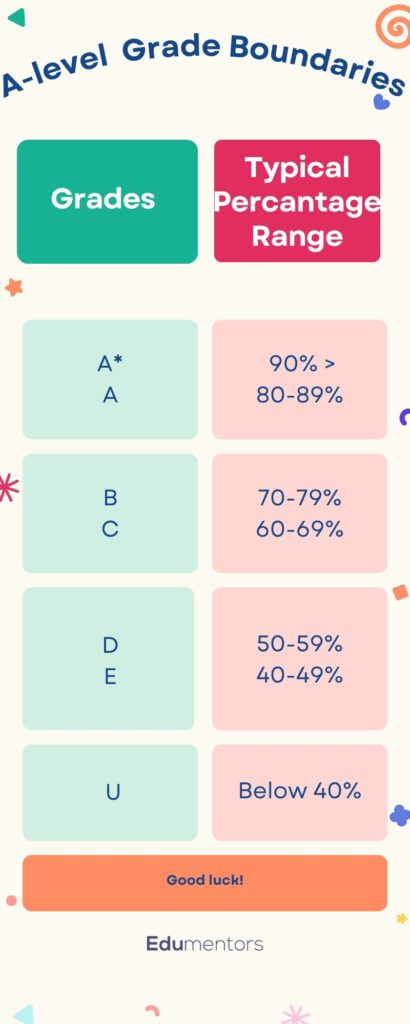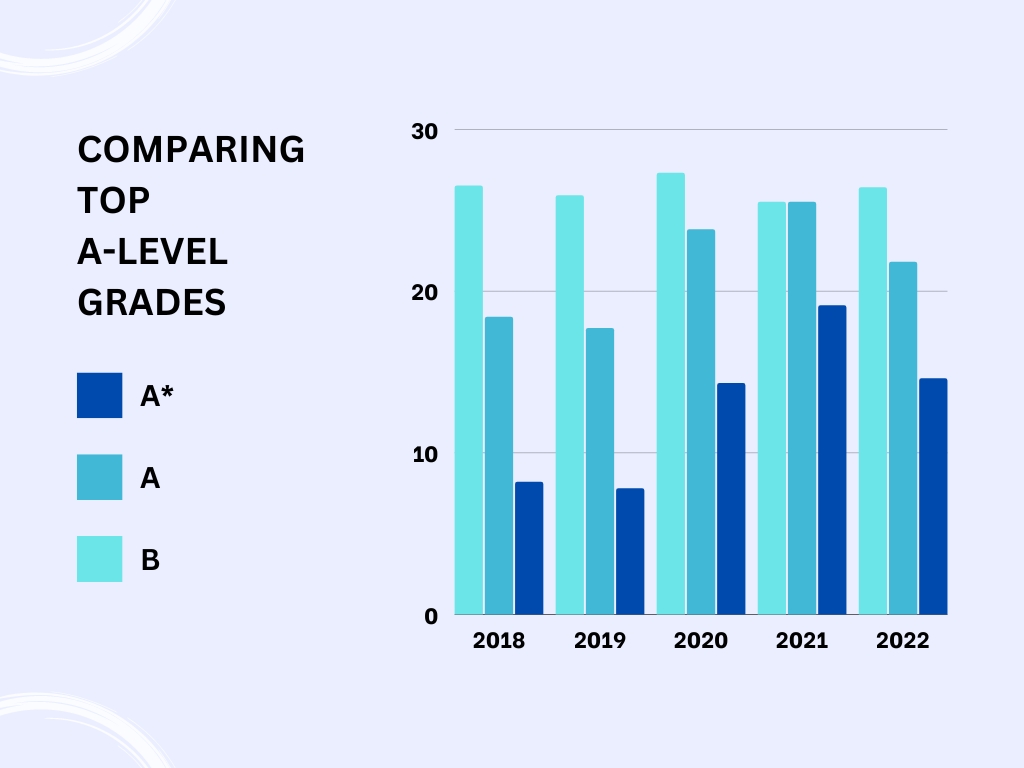A-level Grades – Grade Boundaries Explained 2024
it’s 2024, and A-level grading is evolving yet again, leaving students, parents, and educators on tenterhooks. While many recall the unexpected turns of the pandemic years, the landscape is shifting back, but not entirely to the familiar terrains of yesteryears.
If you’ve found yourself pondering, “Just what exactly are these changes and how might they impact the future of A-level students?”, you’re in the right place. Dive deep with us as we unravel the intricacies of A-level grades, boundary shifts, and what they really mean for the academic landscape.
A-level Grade Boundaries- Quick Look
A-level grade boundaries are the minimum marks a student needs to achieve to obtain a particular grade. These boundaries can vary each year and among different exam boards, subjects, and exam sessions. They are determined after exams have been taken, allowing exam boards to adjust for the difficulty of the test and ensure fairness across years.
For example, a particularly challenging paper might have lower grade boundaries, meaning students can achieve higher grades with fewer marks. Conversely, easier papers might have higher grade boundaries. The goal is to maintain standards over time, ensuring that a grade represents the same level of achievement from year to year, despite variations in exam difficulty.

Background: The Pandemic’s Impact on A-levels

2020 and 2021: years that remain etched in the memory of every A-level student, teacher, and parent. As the world grappled with the unforeseen challenges of a global pandemic, the UK’s education system faced a conundrum of unprecedented proportions. With schools temporarily shutting their gates and traditional exams rendered impractical, the stalwart A-levels faced an upheaval.
During these tumultuous times, centre-assessed grades (CAGs) in 2020 and teacher-assessed grades (TAGs) in 2021 replaced the time-honoured examination process. The outcome? A surge in top grades. The proportion of students achieving the highest accolades soared to heights never before witnessed in the history of A-levels. While many students rejoiced, receiving grades that reflected their hard work and resilience, concerns began to emerge. Would this inflation diminish the perceived value of these qualifications? Would universities and employers question the credibility of such results?
The knock-on effects were palpable. Universities faced oversubscription, with more students meeting their offer conditions. Employers and higher education institutions began to wonder: How could they differentiate between students when so many had top grades?
As we moved into 2022, with the return of in-person exams, there was a slight recalibration. But the echoes of the pandemic years persisted, setting the stage for further deliberation and change in 2023. As we delve into the details of the current year’s grading system, it’s vital to appreciate this background, understanding the motivations and concerns driving the shifts we’re witnessing today.
The Return to Pre-Pandemic Grading

Navigating the post-pandemic landscape, a pressing question loomed over educational authorities: How could we ensure fairness, accuracy, and credibility in the grading system? The back-to-back years of grade inflation, although necessary under the circumstances, posed a challenge. Would a prolonged period of inflated grades diminish the hard-earned reputation of A-levels?
In response, Ofqual, in conjunction with the government, set its sights on a monumental task: orchestrating a return to pre-pandemic grading. The objective was clear — to realign A-level grading with the standards prevalent before the upheaval caused by COVID-19.
Statistical insights reveal the scale of the intended recalibration. While the zenith of the pandemic years saw an abundance of A* and A grades, projections for 2023 suggest a return closer to pre-2020 figures.
Specifically, the proportion of A* grades, which stood at 14.6% in 2022, is now predicted to reduce to around 10% in 2023. Similarly, A grades, which accounted for a substantial 36.4% in 2022, are expected to come down to approximately 27.5%.
This shift isn’t a mere numbers game. It’s underpinned by a profound intent to uphold the integrity of A-levels. Educational stakeholders, including employers and universities, have long valued these qualifications as a benchmark of student capability. The recalibration aims to ensure that A-levels continue to be a gold standard, offering a reliable measure of academic achievement, even in the wake of pandemic-induced changes.
However, it’s crucial to note that while the grading system aims to reflect pre-pandemic standards, it doesn’t negate the unique challenges faced by students in recent years. The goal is balance — between fairness to the current cohort and maintaining the long-term credibility of A-levels in the UK’s academic landscape.
The Role of Ofqual
Navigating the vast, intricate landscape of A-level grading, the Office of Qualifications and Examinations Regulation, more commonly known as Ofqual, has played an indispensable role. As the chief regulator of qualifications, examinations, and assessments in England, its mandate is substantial, ensuring the integrity, consistency, and fairness of exams. In the whirlwind that has been the past few years, their role has become ever more pivotal.
In 2024, their guiding principle is clear: to realign A-level results to the tried and trusted pre-pandemic standards, yet in a manner sensitive to the unique challenges that recent cohorts have faced. While the emphasis is on returning to a semblance of the 2019 grading structure, Ofqual has been explicit about factoring in the pandemic-related disruptions students have encountered. Their directive to exam boards is a balance of retrospection and empathy—mirror the outcomes of 2019, but be attuned to the hurdles of the current student generation.
Beyond providing broad directives, Ofqual has been intricate in its approach to specific subjects. Taking cues from feedback, especially from the last year’s exams, certain subjects have seen nuanced adjustments, all in the spirit of fairness. The body ensures that while standards are maintained, they are not uncompromisingly rigid in the face of genuine difficulties.
In essence, Ofqual’s role is not just that of a regulator but of a guardian—ensuring that the sanctity of the A-levels remains untarnished, while also being the voice of understanding and change in tumultuous times.
UCAS A-level Points Explained
For many A-level students eyeing university places, the UCAS Tariff system, colloquially known as UCAS points, often becomes a crucial metric. It’s a system that translates your academic achievements, from A-levels to other qualifications, into a numerical value. But what are these points, and how exactly do they tie into your university application? Let’s demystify the UCAS points system for A-levels.
The UCAS Tariff system exists to provide a consistent measure, allowing universities to set entry requirements and make conditional offers. Essentially, it’s a way to level the playing field, ensuring that various qualifications across the UK can be equitably compared and contrasted.
For A-levels specifically, the points are typically broken down as follows (though it’s always wise to double-check the latest UCAS updates):
- A*: 56 points
- A: 48 points
- B: 40 points
- C: 32 points
- D: 24 points
- E: 16 points
These points can be vital when considering university offers. If, for instance, a university course requires 112 UCAS points for entry, this could be achieved through various grade combinations, such as two A grades or an A* and a C.
However, while UCAS points offer a simplified and quantified perspective, it’s essential to remember that universities consider much more than just this number. Personal statements, references, interviews, and sometimes specific subject grades play a significant role in admissions decisions. Some competitive courses may demand specific A-level grades rather than a generic UCAS point total.
Moreover, not all institutions or courses use the Tariff system. It’s not uncommon for universities to list their requirements solely in terms of A-level grades. This underscores the importance of researching individual course and institution requirements meticulously.
In a nutshell, while UCAS points provide a handy and standardised metric for university applications, they’re just one piece of the puzzle. They offer a broad overview but remember, every student’s journey is unique, and universities appreciate the richness and diversity that comes with individual narratives and achievements.
Dispelling Myths: The Question of Grade Quotas of A-levels
In the complex world of A-level grading, misconceptions can easily arise. One persistent myth that often clouds understanding is the notion of grade quotas. Let’s delve into this misconception, lay it to rest, and shed light on the actual practices that drive A-level grading. Take a look at our blog about GCSE Grade Boundaries
What are Grade Quotas?
The myth suggests that there are predetermined percentages for each grade, ensuring that only a specific portion of students achieve top grades, while others are relegated to lower tiers. This would imply that A-level grades are distributed on a curve, and students’ achievements are pitted against their peers’.
The Reality: No Set Quotas
Contrary to this myth, there aren’t fixed quotas for A-level grades. Examination boards and Ofqual are clear: grades are awarded based on performance against set standards, not how students perform relative to their peers. While statistical information is used as a guide, it doesn’t dictate the number of students who receive any particular grade.
The Role of Year-on-Year Comparisons
While there’s no quota system, examination bodies do look at year-on-year comparisons. This approach helps maintain standards over time. If there are fluctuations in grade distributions from one year to the next, these are typically due to variations in student performance, not arbitrary grade capping.
Consistency over Competition
The primary goal is consistency. Ensuring that an A grade, for example, reflects the same standard of work year after year is paramount. This way, students, universities, and employers can trust that an A-level grade holds consistent value over time.
Why the Myth Persists
The persistence of this myth could be attributed to observed trends. Some years might see fewer top grades, leading to speculation. However, these variations are typically due to a myriad of factors, from changes in syllabus content to broader educational trends, rather than an artificial quota system.
In conclusion, while the world of A-level grading is intricate, it’s crucial to understand its nuances. Recognising that each student’s grade is a reflection of their own achievement against a consistent standard, rather than a competition against their peers, is fundamental in appreciating the integrity of the system.
Data Used to Determine Grade Boundaries
A-level grading is a sophisticated process, underpinned by a range of data points to ensure fairness, consistency, and credibility. This section will shed light on the primary data types utilised to decide grade boundaries, ensuring that students and educators alike understand the robust mechanisms in place.
The National Reference Test (NRT)
One of the critical data sources is the National Reference Test, which is taken annually by a representative sample of Year 11 students in England. The NRT provides insight into how well students are performing in English and maths. Its outcomes aren’t directly used to adjust grade boundaries, but they offer valuable information on trends in student performance over time.
Key Stage 2 Data
Another significant data source is Key Stage 2 results. While it might seem distant, students’ performance at this earlier educational stage can provide insights into the potential achievement of a cohort. By comparing KS2 results with subsequent GCSE and A-level outcomes, exam boards can establish a more comprehensive understanding of a particular cohort’s educational journey and capabilities.
Historical Grade Distribution
Historical data on grade distributions is also essential. This doesn’t mean replicating results from previous years but rather understanding patterns and anomalies. If one year’s results significantly deviate from historical trends without a clear reason (like curriculum changes), it might prompt a closer review.
Examiner Expertise
While statistical data is invaluable, the expertise of examiners remains at the heart of the grading process. Senior examiners review a range of students’ work at different mark intervals, ensuring that the set boundaries reflect the quality and standard of work expected for each grade.
Feedback from Schools and Colleges
Post-exam feedback from educational institutions is another crucial element. If schools or colleges identify anomalies or unexpected results patterns, these are taken into consideration, ensuring that the grading process remains transparent and receptive.
Conclusion
Navigating the intricate maze of A-levels, with its evolving grading dynamics and shifting goalposts, is no small feat. It’s akin to embarking on a quest that moulds the young minds of today into the luminaries of tomorrow. But while the journey is challenging, it’s vital to remember that each step, each challenge faced, fortifies one’s character, forging resilience and tenacity. Eduqas GCSE Grade Boundaries is also important to understand to dive deep in subject of grades and grade boundaries
In this rapidly transforming educational landscape, having the right allies by your side can make all the difference. Edumentors, an online tutoring platform, where best A-level tutors from UK top universities help with your academic journey . Imagine having a wise fellow traveller, who has just crossed the same terrains you’re navigating, offering insights and lending a helping hand. That’s precisely the essence of Edumentors. Their tutors, distinguished students from the UK’s crème de la crème universities, bring both recent firsthand experience and academic mastery to the table.
But beyond the academics, what they truly offer is the gift of confidence. To know that you’re not alone, to understand that every question, no matter how daunting, has an answer, and to believe that every academic dream is within grasp.








